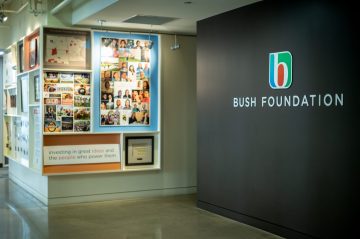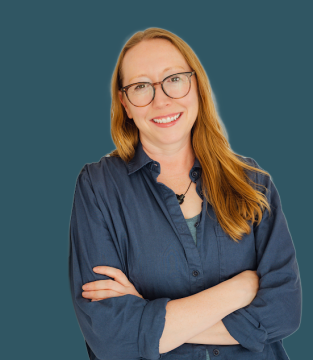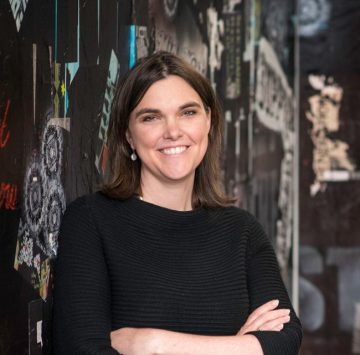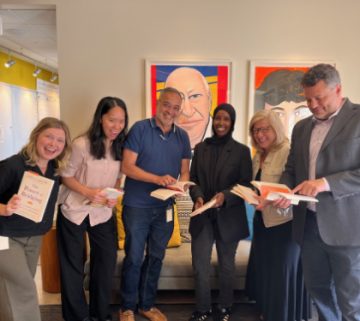Bush Learning
Radically Open: Contact Hub
In this paper, we share what we’ve tried and learned thus far from creating the contact hub to make us more accessible to more people.
DATE
February 14, 2025

The Bush Foundation strives to be a radically open organization, and our contact hub was created in that spirit. We launched the contact hub in 2021 as a universal front door to the Bush Foundation, where anyone from the community can connect with us about the opportunities we offer—and even receive initial feedback about their grant idea or fellowship approach before applying.
The goal of the contact hub is to make us more accessible to people throughout the region—whether we know them or not—and provide a supportive and positive experience for anyone interested in what we do. In some cases, this includes directing them to other resources and opportunities if our funding isn’t a fit.
In this paper, we share what we’ve tried and learned from the contact hub thus far. We hope that it will provide insight to other funders considering how to center community access and equity in their internal processes. It may also help grant-seekers understand more about how we work.
An org-wide strategy
For us, the contact hub represents an organization-wide strategy, not just a tactical process. We believe it can expand the possibilities of what we do while furthering our purpose of inspiring and supporting problem solving across the region. It benefits both potential grantees and the foundation itself. By enhancing our community engagement, the contact hub helps us listen, learn, and build stronger relationships that inform our work and deepen our impact.
Before 2021, we had individual “hotlines” for our programs. These were complex to navigate, especially for those interested in multiple opportunities or unfamiliar with the details of various programs. While our staff support received positive feedback, we knew we could do better, especially for people who don’t know the range of opportunities we offer (which is most people!) or who wanted feedback before putting time into an application.
The contact hub simplifies things by offering a single phone number and email address for any inquiry. Then, we make it our responsibility to get that inquiry to the right staff person. For deeper questions or explorations, people can choose to schedule a 30-minute chat with a member of our grantmaking team. By being open to every inquiry, we hope to ensure everyone has access to what they need.
The contact hub is also an opportunity for us to add value beyond grantmaking by sharing our regional knowledge and relationships. For example, someone might call us to test an idea for a Community Innovation grant. During that conversation, we can share feedback and potentially offer connections to other people and resources that might be helpful.
Applying a learning lens to the contact hub means it enhances our work as much as it benefits those who reach out to us. The communications team, which coordinates the contact hub, collaborates with our learning and evaluation team and other colleagues to gather and synthesize insights from community conversations. These insights help us continuously improve—whether by refining language on our website or adapting our broader program strategies.
Defining success
Building the contact hub as a universal front door required lots of collaboration across the Foundation, as it was a change in both mindsets and mechanics. A small team of staff led its development and launch in less than a year, through an inclusive process with leadership and colleagues across functions. They defined success as:
Be more accessible.
- Remove barriers and ensure reachability by anyone in our region, while accommodating different types of users and specific needs.
- Use data to identify gaps in who we are reaching and inform our sourcing/engagement efforts.
Offer great experiences and helpful information to our community stakeholders.
- Use a coaching-style approach to help people find what they need, including information on Bush-operated and -supported programs and resources from other organizations and foundations.
- Provide a flexible and equitable experience.
Make the Bush Foundation better.
- Learn as much as we can about challenges and opportunities in the region to inform our work.
- Connect with more people and organizations to help source high-potential applicants and increase our value beyond our grantmaking.
Key implementation steps
While not comprehensive, the key parts of bringing the contact hub to life included:
- Introducing the contact hub concept to staff as a different way of engaging community and achieving buy-in through inclusive design and multiple feedback points before and after launch.
- Setting up key technical components, including a scheduling system, sign-up form, and CRM integration to streamline staff coordination and data collection.
- Cross-training to ensure every grantmaking staff person can explain every grant program well.
- Shaping and assigning a contact hub coordinator role.
- Reshaping staff time to allow grantmaking officers enough space in schedules to contribute 2-4 hours per week toward contact hub conversations. (This commitment has grown over time as the demand for appointments has increased.)
- Promoting the contact hub in various communications and ensuring all program info, including throughout our website, points people toward the contact hub.
- Developing ways to collect and integrate learning from contact hub conversations and data collection into our overall learning and improvement strategy.
What we’re learning
The contact hub has proven to be a valuable addition to the Bush Foundation, making it easier for people to connect with us and giving us additional ways to provide value to individuals and organizations in the region we serve. We’re having more conversations, guiding individuals to the right programs, recommending relevant resources, and helping those who may not be a fit for our opportunities save time and effort.
The number of contact hub interactions has exceeded our expectations and is evidence that it’s working as a means of access. We’ve also heard anecdotal appreciation from the community for our increased availability.
To deepen our understanding of accessibility, we’re now tracking where inquiries come from and who is reaching out. This data helps us identify who finds us accessible—and who doesn’t.
What we’re tracking
To consider our impact with the contact hub, we’re tracking some key measures to help us understand how it’s working and also to inform our larger engagement strategy. They include:
- Number of completed inquiry appointments with grantmaking staff that were scheduled through our website form. In 2024, we counted 862!
- Geographic access, based on zip code tracking across our region. In 2024, about 70% of total appointments originated from locations in MN, 8% in ND and 8% in SD, with the remaining 14% being mostly from outside the region we serve.
- Race/ethnicity access—an optional question asked of individuals. In 2024, among the 765 people who responded with one or more selection, 12% identified as American Indian/Alaska Native, 7% Asian/Asian American, 34% Black/African American, 7% Hispanic or Latino, <1% Native Hawaiian/other Pacific Islander, 45% White and 3% some other race.
- First-time connections with newly created organizations or those not already in our grantmaking database. We’re still building a way to analyze this, but staff say they’re regularly connecting with new organizations and emerging leaders in the region.
We also track specific metrics to help manage our staff capacity, like:
- Number of scheduled and unscheduled phone inquiries and email inquiries
- Average combined number of hours per week of dedicated staff coverage compared to availability of appointments
What we’re working on next
- We’re paying close attention to who we are not hearing from and exploring potential barriers—whether language, technology, or a lack of trust built over time.
- We want to better integrate insights from contact hub conversations across the organization to improve our work. While we’ve made progress in documenting conversations, there’s room to improve in applying these learnings across the Foundation.
- We hope to deepen the value of contact hub conversations by making philanthropy feel less mysterious and more connected to real community challenges and opportunities.
- Contact hub conversations are 30-minute, virtual sessions that work well for some, but not for everyone. We continue to assess whether this is the best format, while exploring ways to complement it with other engagement opportunities, such as office hours and participation in live community events.
- We hope to refine our use of the online scheduling tool, Calendly, and its Outlook integration. While it streamlines scheduling, it requires significant staff time to manage appointments.
- We continue to assess and look for ways to improve our responsiveness, particularly during high-demand periods, such as the Bush Fellowship application cycle.
- There’s still room to improve the staff experience and ensure they can balance their contact hub engagement with other responsibilities. While all inquiries are important to us, only a small percentage lead to a grant or fellowship. It’s been critical to keep staff engaged in how this work is aligned with our broader mission of inspiring and supporting problem solving across the region. Success for us is being accessible, having conversations, and sharing resources—whether or not the engagement results in an application or grant.
If you are interested in learning more about what we did, please don’t hesitate to reach out to us at staff@bushfoundation.org.
Download the learning paper (PDF)
Contributors
Bush Foundation staff members who played significant roles in the creation, implementation and operations of the contact hub include: Farhiya Abdulkarim, Kassira Absar, Amy Anderson, Stephanie Andrews, Kevin Bruins, Justin Christy, Katie Foy, Jen Jang, Kallie O’Hara, Anita Patel, Jen Ford Reedy, Kari Ruth and Kristina Ward. And an extra special shout out to our grantmaking officers who respond to all the inquiries!
Continue reading
-

News
Welcome to new Bush staff members
We are celebrating some new Bush colleagues and hope you get to meet them soon!
-

Note from Jen
Protecting our freedom to give
Do you know how CPR came to be? What about the 911 system? Ever wonder who developed the Pap smear? Or why school buses are all the same color? All these were the results of work funded by some foundation.
-

News
Introducing the Bush book club
Join us as we learn how to build a world where we all belong. And stay tuned as we get ready to welcome john a. powell to Minnesota for a special Bush book club event!